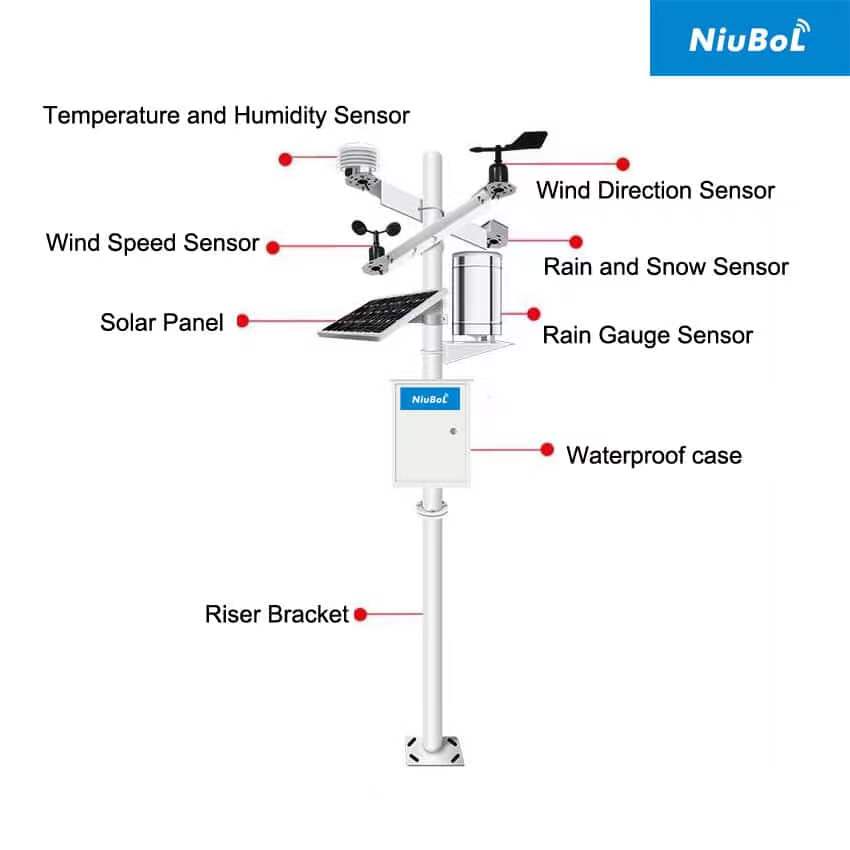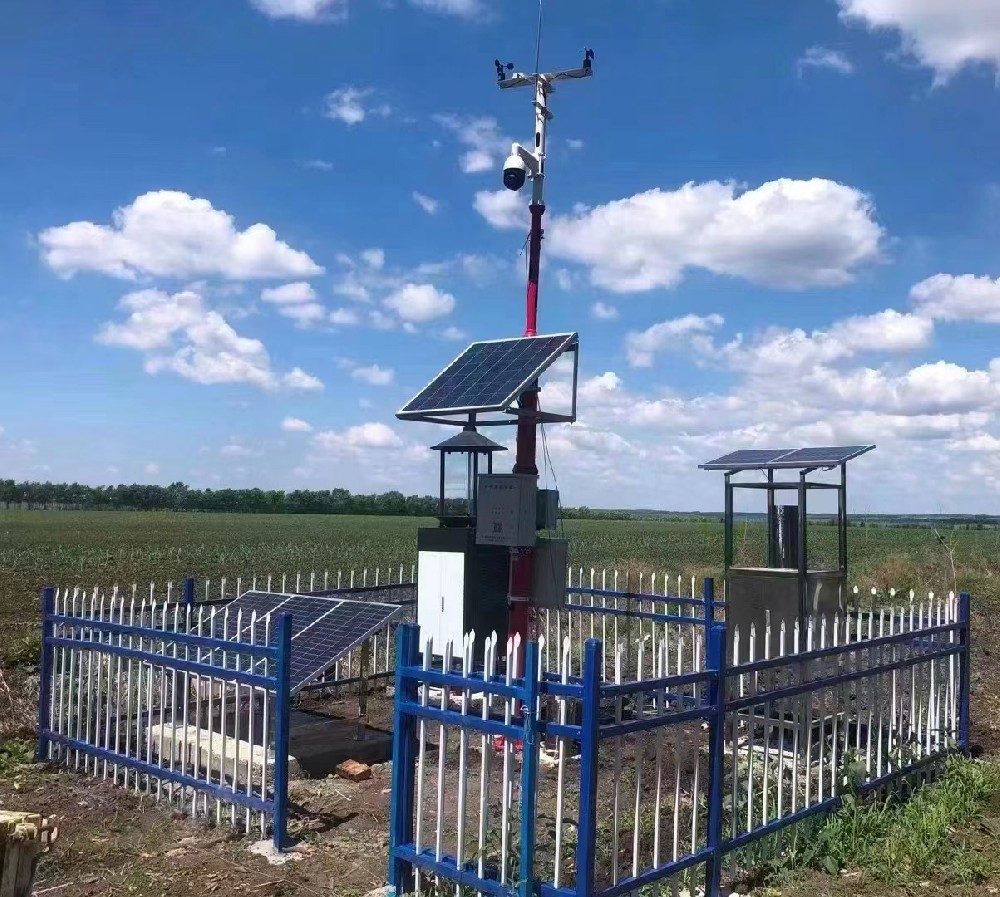

— Products —
 Consumer hotline +8618073152920
Consumer hotline +8618073152920 WhatsApp:+8615367865107
Address:Room 102, District D, Houhu Industrial Park, Yuelu District, Changsha City, Hunan Province, China
All products
Agricultural Weather Station ( Agriculture Weather Station ) is a meteorological observation equipment specially applied in the field of agricultural production, which is used to monitor and record meteorological parameters that are closely related to agricultural production. It combines a variety of modern scientific and technological means such as Internet of Things (IoT) technology, wireless communication sensors, etc. They usually include a series of sensors for measuring···
Tel/WhatsApp:+8615367865107
Email:Arvin@niubol.com +Nearly 100 partner company in more than 68 countries. We are committed to providing high-quality, practical products to meet your needs and help you solve problems.Product Details
Agricultural Weather Station ( Agriculture Weather Station ) is a meteorological observation equipment specially applied in the field of agricultural production, which is used to monitor and record meteorological parameters that are closely related to agricultural production. It combines a variety of modern scientific and technological means such as Internet of Things (IoT) technology, wireless communication sensors, etc. They usually include a series of sensors for measuring meteorological sensors such as air temperature sensors, humidity sensors, wind speed sensors, wind direction sensors, snow sensors, precipitation sensors, etc., as well as soil sensors such as soil temperature sensors and soil moisture sensors. It realizes automatic monitoring of air temperature, humidity, soil moisture, soil temperature, wind speed, wind direction, rainfall, light intensity and other conventional meteorological elements.
| Measured | Measuring range | Resolution | Precision |
| Humidity | 0~100%RH | 0.1%RH | ±0.5℃ |
| Temperature | -40~80℃ | 0.1℃ | ±5%RH |
| Atmospheric pressure | 10~1200hPa | 0.1hPa | ±1.5hPa |
| Soil temperature | -40~80℃ | 0.1℃ | ±0.5℃ |
| Soil Humidity (moisture) | 0-100%RH | 0.1%RH | ±5%RH |
| Conductivity | 0-10000us/cm | 1us/cm | ±5% |
| Wind speed | 0~70m/s | 0.1m/s | ±(0.3+0.03V)m/s |
| wind direction | 0~360° | - | ±3° |
| Illuminance | 0-200000Lux | - | ±7% |
| Rainfall | 0-4mm/min | 0.2mm | ±4% |
| Solar radiation | 0~2000W/m2 | - | ≤5% |
| CO2 | 0~2000ppm | 1ppm | ±7% |
| Supply mode | 220V | DC12-24V | solar power optional |
 |  |  |  |  |
| Anemometer Wind Speed sensor | Wind direction sensor | Tipping bucket rain gauge sensor | Tipping bucket rain gauge sensor | Piezoelectric Rain Gauge |
 |  |  |  |  |
| Atmospheric Temperature Humidity air pressure Sensor | ultrasonic wind speed and direction sensor | 5 in1 Ultrasonic Weather Station Sensor | All-in-One Weather Station | 7 in1 Ultrasonic Weather Station Sensor |
 |  |  |  |  |
| Solar Radiation Sensor | Solar Radiation Sensor | Photosynthetically Active Radiation Sensor; | illumination sensor | Ultrasonic Snow Depth Sensor |
 |  |  |  |  |
| Fruit Growth Sensor | Carbon dioxide(CO2) sensor | 7 in 1 Soil Integrated Sensor | 8 in 1 Integrated Soil Sensor | Soil Moisture Temperature sensor |
The main components of the agrometeorological station include sensors, data collectors, data storage devices and data transmission devices. Sensors are used for real-time monitoring of meteorological and soil parameters, data collectors are responsible for collecting data collected by sensors, data storage devices are used for storing historical data, and data transmission devices can transmit data to data centers or user terminals through wireless or wired means.
The agrometeorological station has the functions of real-time collection, wireless transmission, automatic storage, over-limit warning, data analysis, etc. It has a wide measurement range, timely data transmission, simple operation, good protection, and strong compatibility, and supports the combination of hardware and software. These characteristics make the agricultural weather station can realize the real-time data online monitoring of the agricultural production environment, as well as the timely reminder of abnormal data, providing strong technical support for agricultural production.

1. temperature sensor: used to monitor the air temperature, which has an important impact on the growth cycle of crops and the occurrence of pests and diseases.
2. humidity sensor: to measure the humidity in the air, which is essential for understanding crop water requirements and soil moisture status.
3. wind speed and direction sensors: wind can affect crop growth and the spread of diseases, so it is important to monitor wind speed and direction.
4. rainfall sensors: measure rainfall, which is critical for irrigation management and crop growth.
5. sunlight sensors: monitor the duration and intensity of sunlight, which has a direct impact on crop photosynthesis and yield.
6. soil moisture sensors: measure soil moisture at different depths to help farmers understand soil moisture conditions to decide when and how much to irrigate.
7. Radiation Sensors: Monitor soil and crop radiation levels, which are important for assessing crop growth and developing appropriate management practices.

Agricultural Weather Stations are widely used in agriculture, forestry, grassland, ecology, parks and other scenarios for microclimate monitoring and pest and disease reporting. Through real-time monitoring and analysis of meteorological parameters, Agricultural Weather Stations can help agricultural technicians better understand the growing environment of crops, predict the growth of crops, and provide scientific basis for agricultural production. In addition, agricultural weather stations can also be used to assist scientific research and teaching, and promote the intelligent and digital application of agricultural technology.
1. Crop management: Agricultural weather stations can provide real-time meteorological data and soil data to help farmers monitor the climatic conditions and soil status, so as to optimize the planting and management strategies of crops, including irrigation, fertilizer application, and disease and pest control.
2. Disaster early warning: By monitoring meteorological data, agrometeorological stations can provide early warning of extreme weather events (e.g. heavy rainfall, drought, freezing, etc.), helping farmers to take timely precautions to minimize losses caused by natural disasters.

3. Agricultural insurance: Agricultural meteorological stations can provide reliable meteorological data, which can be used as the basis for agricultural insurance companies to formulate insurance programs and settle claims, helping farmers to reduce business risks.
4. Scientific research and education: meteorological data and soil data provided by agricultural weather stations can be used in agricultural research and educational practices, helping researchers and students to gain a deeper understanding of the relationship between meteorology and agricultural production.
5. Irrigation planning: By monitoring soil moisture and weather forecasts, irrigation can be planned more efficiently and water resources can be saved.
6. Pest and disease monitoring: Data such as temperature, humidity and wind speed can help predict and monitor the occurrence of pests and diseases.
7. Agricultural product market decision-making: Agrometeorological data can be used to predict the yield and quality of agricultural products, thus influencing market decisions.
The construction and development of agro-meteorological stations in various countries have been given high priority by Governments, as they play an important role in guaranteeing food security and promoting the modernization of agriculture. With advances in technology, these weather stations are now increasingly using automation and remote monitoring technologies, which improve the efficiency of data collection and analysis.

In conclusion, agrometeorological stations have important applications in agricultural production management, disaster prevention, agricultural insurance and research and education to improve the efficiency and quality of agricultural production and reduce risks and losses. It provides accurate and real-time meteorological data service for agricultural production, which is of great significance for improving the efficiency of agricultural production and promoting the sustainable development of agriculture.
Prev:Leaf moisture sensor
Sensors & Weather Stations Catalog
Agriculture Sensors and Weather Stations Catalog-NiuBoL.pdf
Weather Stations Catalog-NiuBoL.pdf
Related recommendations
 Multi-Depth Soil Sensor RS485
Multi-Depth Soil Sensor RS485 TDR Soil Moisture Sensor
TDR Soil Moisture Sensor Pyranometer Solar Radiation Sensors
Pyranometer Solar Radiation Sensors Soil ph sensor
Soil ph sensor Tipping Bucket Rain Gauge
Tipping Bucket Rain Gauge Air Temperature and Humidity Sensor
Air Temperature and Humidity Sensor
Screenshot, WhatsApp to identify the QR code
WhatsApp number:+8615367865107
(Click on WhatsApp to copy and add friends)